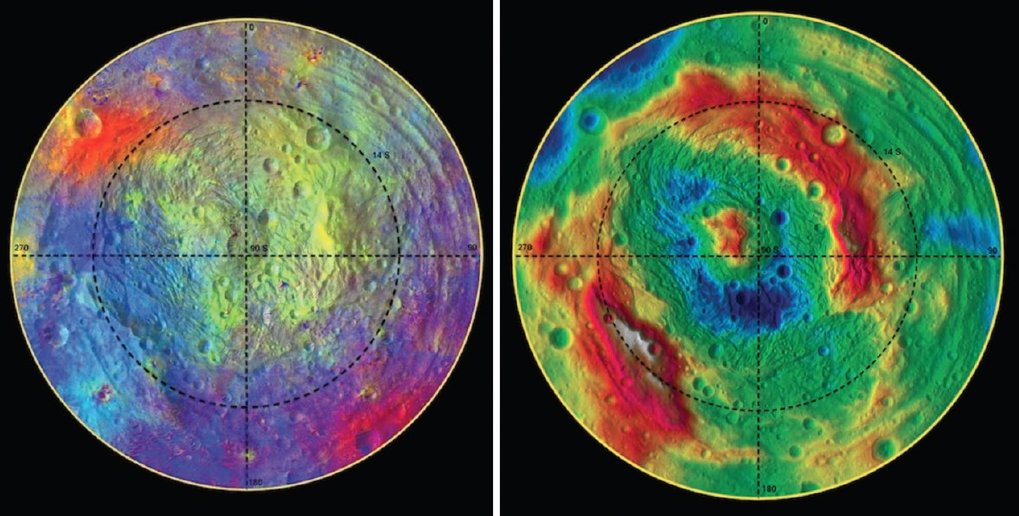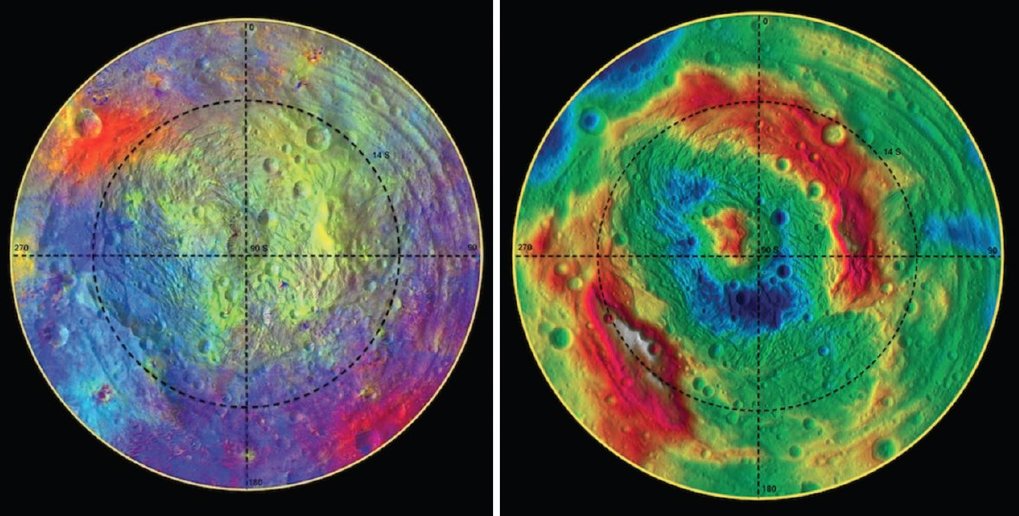Vesta seen in colors
New results prove that Dawn’s target asteroid is a relict from an early phase of planetary evolution
The cameras on board NASA’s space probe Dawn are helping to disclose the secrets of the asteroid Vesta. New color images confirm that Vesta is a relict from an early phase of our solar system. The surprisingly heterogeneous body is more similar to a planet than to a primitive asteroid. In addition, new studies prove that most of the HED-meteorites, a special class of meteorites, are fragments of Vesta. Scientists from the Max-Planck-Institute for Solar System Research in Germany describe their current results in tomorrow’s issue of Science Magazine.

Since the summer of 2011, two cameras have been orbiting the asteroid Vesta on board NASA’s Dawn spacecraft – one operational, one a back-up. With the help of this camera system, that was developed and built under the lead of the Max-Planck-Institute for Solar System Research, the space probe has been supplying researchers with image data from the previously unexplored asteroid. The so-called framing cameras are equipped with seven color filters and one clear filter and are therefore much more powerful than “normal” cameras: The color filters can decode the exact components of the light that Vesta reflects back into space. By this means, the scientists can map the surface and infer the mineralogical composition of the asteroid.
After only ten months of detailed studies, the scientists are now certain, that Vesta is different from all other asteroids visited by space probes. The asteroid is a sort of living fossil of planetary evolution. Even its diameter is extraordinary: at 525 kilometers, Vesta is the third largest asteroid. “Vesta is a protoplanet”, explains Andreas Nathues from the Max-Planck-Institute for Solar System Research, Framing Camera Lead Investigator. “It stands for an early evolutionary stage that later developed into planets such as Earth or Mars. Most likely, Vesta is the last specimen of these types of bodies”, he adds. The data obtained from other instruments on board the probe support this interpretation.
Until now, Vesta had only been studied from telescopes on or close to Earth. The data obtained by the framing camera currently in orbit offers surprises: “Nobody expected the amazing differences in brightness that we found on Vesta’s surface”, says Lucille Le Corre from the Max-Planck-Institute for Solar System Research. “While Vesta’s brightest regions are as bright as snow, the darkest ones are as dark as coal. No other asteroid visited so far by space probes has shown such diversity.”
The great differences between the north and southern hemispheres are also striking. They can be inferred from the different colors the framing cameras found on Vesta’s surface. In particular, those differences in coloring are interesting because they point to material previously studied in a special class of meteorites, the so-called HED-meteorites, that fell to Earth. The abbreviation stands for howardite, eucrite, and diogenite. Because their reflectance spectra are similar to Vesta’s, these meteorites have long been suspected to be fragments coming from the giant asteroid. It was therefore another important goal of the mission to confirm this link.
Eucrite is material from the crust, similar to basalt on Earth, whereas diogenite originates from deeper within the crust. Howardite is a mixture of both types of material that is created during impact events and forms a layer of regolith on the surface. “The images obtained with the framing camera now show distinct differences in color between regions with material originating within the asteroid in the Southern hemisphere and regions characterized by surface material”, says Nathues. “Together with the observations performed by other instruments on board we were finally able to clarify the place of origin of the HED-meteorites. It really is Vesta.”
The new studies also revealed that Vesta – unlike for example the Moon – does not have a clear global correlation between topography and color. On the Moon, the darkest areas correspond to the topographic lows, while the brighter areas correspond to regions of higher altitude. On Vesta, however, this is generally not true.
Dawn will continue to orbit Vesta until August 2012 and then depart for its second destination: the largest member of the asteroid belt, Ceres. “Dawn’s visit to Vesta has confirmed our broad theories of this giant asteroid’s history, while also helping to fill in details it would have been impossible to know from afar,” said Carol Raymond, deputy principal investigator based at NASA’s Jet Propulsion Laboratory.
NASA’s Dawn spacecraft was launched in September 2007 and entered an orbit around Vesta on July 16th, 2011. The Dawn mission to Vesta and Ceres is managed by NASA's Jet Propulsion Laboratory, a division of the California Institute of Technology in Pasadena, for NASA's Science Mission Directorate, Washington. The University of California, Los Angeles, is responsible for overall Dawn mission science. The Dawn framing cameras have been developed and built under the leadership of the Max Planck Institute for Solar System Research, Katlenburg-Lindau, Germany, with significant contributions by DLR German Aerospace Center, Institute of Planetary Research, Berlin, and in coordination with the Institute of Computer and Communication Network Engineering, Braunschweig. The Framing Camera project is funded by the Max Planck Society, DLR, and NASA/JPL.
